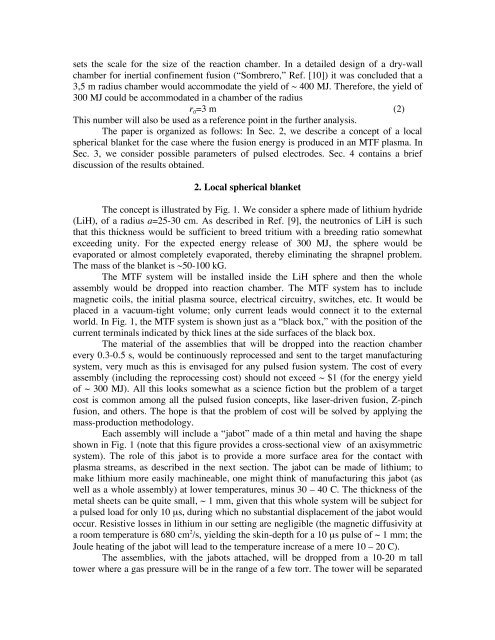solving the stand-off problem for magnetized target fusion - OSTI
solving the stand-off problem for magnetized target fusion - OSTI
solving the stand-off problem for magnetized target fusion - OSTI
You also want an ePaper? Increase the reach of your titles
YUMPU automatically turns print PDFs into web optimized ePapers that Google loves.
sets <strong>the</strong> scale <strong>for</strong> <strong>the</strong> size of <strong>the</strong> reaction chamber. In a detailed design of a dry-wall<br />
chamber <strong>for</strong> inertial confinement <strong>fusion</strong> (“Sombrero,” Ref. [10]) it was concluded that a<br />
3,5 m radius chamber would accommodate <strong>the</strong> yield of ~ 400 MJ. There<strong>for</strong>e, <strong>the</strong> yield of<br />
300 MJ could be accommodated in a chamber of <strong>the</strong> radius<br />
r 0 =3 m (2)<br />
This number will also be used as a reference point in <strong>the</strong> fur<strong>the</strong>r analysis.<br />
The paper is organized as follows: In Sec. 2, we describe a concept of a local<br />
spherical blanket <strong>for</strong> <strong>the</strong> case where <strong>the</strong> <strong>fusion</strong> energy is produced in an MTF plasma. In<br />
Sec. 3, we consider possible parameters of pulsed electrodes. Sec. 4 contains a brief<br />
discussion of <strong>the</strong> results obtained.<br />
2. Local spherical blanket<br />
The concept is illustrated by Fig. 1. We consider a sphere made of lithium hydride<br />
(LiH), of a radius a=25-30 cm. As described in Ref. [9], <strong>the</strong> neutronics of LiH is such<br />
that this thickness would be sufficient to breed tritium with a breeding ratio somewhat<br />
exceeding unity. For <strong>the</strong> expected energy release of 300 MJ, <strong>the</strong> sphere would be<br />
evaporated or almost completely evaporated, <strong>the</strong>reby eliminating <strong>the</strong> shrapnel <strong>problem</strong>.<br />
The mass of <strong>the</strong> blanket is ~50-100 kG.<br />
The MTF system will be installed inside <strong>the</strong> LiH sphere and <strong>the</strong>n <strong>the</strong> whole<br />
assembly would be dropped into reaction chamber. The MTF system has to include<br />
magnetic coils, <strong>the</strong> initial plasma source, electrical circuitry, switches, etc. It would be<br />
placed in a vacuum-tight volume; only current leads would connect it to <strong>the</strong> external<br />
world. In Fig. 1, <strong>the</strong> MTF system is shown just as a “black box,” with <strong>the</strong> position of <strong>the</strong><br />
current terminals indicated by thick lines at <strong>the</strong> side surfaces of <strong>the</strong> black box.<br />
The material of <strong>the</strong> assemblies that will be dropped into <strong>the</strong> reaction chamber<br />
every 0.3-0.5 s, would be continuously reprocessed and sent to <strong>the</strong> <strong>target</strong> manufacturing<br />
system, very much as this is envisaged <strong>for</strong> any pulsed <strong>fusion</strong> system. The cost of every<br />
assembly (including <strong>the</strong> reprocessing cost) should not exceed ~ $1 (<strong>for</strong> <strong>the</strong> energy yield<br />
of ~ 300 MJ). All this looks somewhat as a science fiction but <strong>the</strong> <strong>problem</strong> of a <strong>target</strong><br />
cost is common among all <strong>the</strong> pulsed <strong>fusion</strong> concepts, like laser-driven <strong>fusion</strong>, Z-pinch<br />
<strong>fusion</strong>, and o<strong>the</strong>rs. The hope is that <strong>the</strong> <strong>problem</strong> of cost will be solved by applying <strong>the</strong><br />
mass-production methodology.<br />
Each assembly will include a “jabot” made of a thin metal and having <strong>the</strong> shape<br />
shown in Fig. 1 (note that this figure provides a cross-sectional view of an axisymmetric<br />
system). The role of this jabot is to provide a more surface area <strong>for</strong> <strong>the</strong> contact with<br />
plasma streams, as described in <strong>the</strong> next section. The jabot can be made of lithium; to<br />
make lithium more easily machineable, one might think of manufacturing this jabot (as<br />
well as a whole assembly) at lower temperatures, minus 30 – 40 C. The thickness of <strong>the</strong><br />
metal sheets can be quite small, ~ 1 mm, given that this whole system will be subject <strong>for</strong><br />
a pulsed load <strong>for</strong> only 10 µs, during which no substantial displacement of <strong>the</strong> jabot would<br />
occur. Resistive losses in lithium in our setting are negligible (<strong>the</strong> magnetic diffusivity at<br />
a room temperature is 680 cm 2 /s, yielding <strong>the</strong> skin-depth <strong>for</strong> a 10 µs pulse of ~ 1 mm; <strong>the</strong><br />
Joule heating of <strong>the</strong> jabot will lead to <strong>the</strong> temperature increase of a mere 10 – 20 C).<br />
The assemblies, with <strong>the</strong> jabots attached, will be dropped from a 10-20 m tall<br />
tower where a gas pressure will be in <strong>the</strong> range of a few torr. The tower will be separated
















